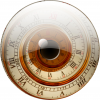Just been reminded of a thought I had some years back. I'm curious as to what algorithm Xara actually uses for its antialiasing or (assuming that's a trade secret) what assumptions it makes about the display.
It would appear that the results are slightly better on a CRT than an LCD - although it may just be that my laptop has a cheap screen. I was wondering whether there's any scope for expanding the display options. Targetting an LCD - with rectangular, limited pixels and the possibility of doing ClearType style resolution enhancement - is quite different from targetting a CRT with a gaussian blurred pixel. As more professional artists get to play with desktop LCD panels, this may become more relevant.
The same issue appears with sampling for printing - I hear Xara may be improving upon nearest-neighbour for bitmap printing; might there be some scope for supporting various sized filter kernels for image export, too? There might also be some scope in automatic hinting, given knowledge of the printer screen, but there's probably a PhD project in there somewhere...
There may be some correlation between trying to do this and the "group transparency" (which I take to mean the equivalent of rendering the group to an appropriate resolution bitmap and then placing the bitmap on the page with a given transparency - allowing for group components to be partly transparent as well; but it could mean something totally different for all I know) which got pulled from Xara X. Being able to create a shape which antialiases to the background, rather than components of itself (for overlaid edges) would be useful. As would the general concept of being able to lock a group to, for example, the transparency channel (in place of bitmap transparency - perhaps this is in fact what group transparency does?)
Whatever Xara does, it's certainly very effective - and fast; I'm just interested in whether there's a chance of future improvements in quality, at least for output where speed is less important.
Yours technically,
Andrew Garrard



 Reply With Quote
Reply With Quote



Bookmarks